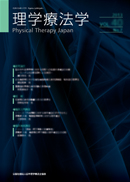All issues

Volume 39, Issue 6
Displaying 1-5 of 5 articles from this issue
- |<
- <
- 1
- >
- >|
Reseach Reports
-
Akira OCHI, Takumi OTAKE, Kazumasa YAMADA, Tomokazu ABE, Kiminobu FURU ...Article type: Article
2012 Volume 39 Issue 6 Pages 351-358
Published: October 20, 2012
Released on J-STAGE: August 25, 2018
JOURNAL FREE ACCESSPurpose: The purpose of this study was to clarify the influence of age-related differences on attentional focus effects in the reaction time and the movement pattern of the involuntary front single step.
Methods: Eight healthy elderly women and eight healthy young men were released from a forward-leaning position and instructed to regain standing balance by taking a single step forward. The involuntary step was induced while carrying out three cognitive tasks: 1) simple front-fixed gaze as control condition; 2) Color word reading as displayed every one sec; and 3) Color word reading as a word is displayed in a color different from the color it actually names. This task is called stroop task. Lower extremity spatiotemporal parameters, foot-floor reaction time, and thigh muscle activity were measured during the step responses.
Results: The delay of foot-floor reaction time and the increase of knee extension muscle activity after the step landing were found only in the elderly stroop task compared with control task. The step length and step velocity were significantly decreased in the elderly in comparison with the young subjects, but there was no difference among the cognitive tasks.
Conclusion: In the elderly, a delay in the fall prevention step reaction after tripping is predicted when the elderly is distracted by attention-demanding tasks. This study also shows that there is no change in step movement velocity for a step delay.View full abstractDownload PDF (5981K)
Brief Report
-
Syouji ITO, Kiyokazu SEKIKAWA, Shunsuke TAITO, Kana KONISHI, Sayaka DO ...Article type: Article
2012 Volume 39 Issue 6 Pages 359-364
Published: October 20, 2012
Released on J-STAGE: August 25, 2018
JOURNAL FREE ACCESSPurpose: The purpose of the present study was to examine the effects of smoking on muscle oxygenation during localized muscular exercise.
Methods: The subjects included 9 young smokers and 9 nonsmokers. Near-infrared spectroscopy (NIRS) was used to assess muscle oxygenation in the right vastus lateralis muscle during 30 repeated maximal isokinetic knee extensions at high angular velocity (300 degrees per sec) and 5 repeated extensions at low angular velocity (60 degrees per sec).
Results: During the high angular velocity extensions, the time course of the NIRS parameters were not significantly different between two groups. In contrast, during the low angular velocity extensions, time-related changes in Oxy-Hb・Mb and Total-Hb・Mb were significantly different in the two groups. We also showed that Oxy-Hb・Mb was significantly lower in smokers than in nonsmokers during the latter period of the exercise.
Conclusion: These results indicate that the ability to deliver oxygen to active muscles to satisfy oxygen demand in young smokers is limited compared to nonsmokers during isokinetic knee extension at higher torque and low angular velocity.View full abstractDownload PDF (731K)
Clinical Guide Series
-
Hiroko Shiomi, Nami KawanoArticle type: Article
2012 Volume 39 Issue 6 Pages 365-372
Published: October 20, 2012
Released on J-STAGE: August 25, 2018
JOURNAL FREE ACCESSDownload PDF (10600K)
Clinical Practical Series
-
Masaki Ishikawa, Kan Sasaki, Michiaki TakagiArticle type: Article
2012 Volume 39 Issue 6 Pages 373-377
Published: October 20, 2012
Released on J-STAGE: August 25, 2018
JOURNAL FREE ACCESSDownload PDF (35194K)
47th Annual Congress of the Japanese Physical Therapy Association
Special Interest Groups: Educational Lecture
-
Satoru UchiyamaArticle type: Article
2012 Volume 39 Issue 6 Pages 378-381
Published: October 20, 2012
Released on J-STAGE: August 25, 2018
JOURNAL FREE ACCESSDownload PDF (570K)
- |<
- <
- 1
- >
- >|